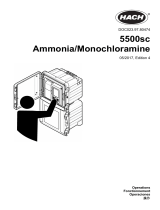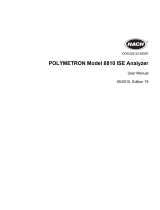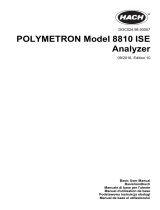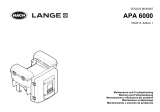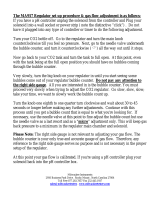Page is loading ...

Catalog Number 4195M0040
1950Plus UV Process TOC Analyzer
Instrument Manual
8/06 3ed
© Hach Company, 2002, 2003, 2006. All rights reserved. Printed in the U.S.A. te/kt

Page 2
4195M0040title page.fm

Page 3
4195M0040TOC.fm Table of Contents
Table of Contents
Safety Precautions.................................................................................................................................................... 7
Use of Hazard Information.................................................................................................................................. 7
Potential Safety Hazards.................................................................................................................................... 7
Precautionary Labels.......................................................................................................................................... 8
Electrical and Burn Precautions ......................................................................................................................... 8
Précautions à prendre pour éviter les brûlures et les risques électriques.......................................................... 8
Venting Waste Gases......................................................................................................................................... 9
Décharge des gaz usés...................................................................................................................................... 9
Chemical Precautions......................................................................................................................................... 9
Précautions à prendre contre les risques chimiques.......................................................................................... 9
Carrier Gas Precautions..................................................................................................................................... 9
Précautions à prendre à l'égard du gaz vecteur............................................................................................... 10
Sample Stream Precautions............................................................................................................................. 10
Précautions à prendre à l'égard du flux d'échantillon....................................................................................... 10
Disposing of used UV Lamps........................................................................................................................... 11
Élimination des lampes UV usées.................................................................................................................... 11
Technical Specifications ......................................................................................................................................... 13
Section 1 Introduction.......................................................................................................................................... 15
1.1 System Description........................................................................................................................................... 15
1.2 Applications....................................................................................................................................................... 15
1.3 Major Components............................................................................................................................................ 15
1.3.1 Liquids Enclosure .................................................................................................................................... 17
1.3.2 Electronics Enclosure.............................................................................................................................. 17
1.3.3 Front Panel .............................................................................................................................................. 20
1.4 Analysis Process............................................................................................................................................... 20
1.5 Installation......................................................................................................................................................... 21
1.6 Start-up and Operation ..................................................................................................................................... 21
1.7 Calibration......................................................................................................................................................... 21
1.8 Miscellaneous ................................................................................................................................................... 21
1.9 Technical Support and Assistance.................................................................................................................... 21
1.10 EPA Mode ....................................................................................................................................................... 22
1.10.1 Connection Information ......................................................................................................................... 23
Installation............................................................................................................................................................. 25
Section 2 Unpacking, Installation, and Setup .................................................................................................... 27
2.1 Unpacking and Installation................................................................................................................................ 27
2.1.1 Unpacking and Inspection ....................................................................................................................... 27
2.1.2 Location Criteria ...................................................................................................................................... 27
2.2 Wiring the Instrument........................................................................................................................................ 30
2.2.1 Wiring the Instrument for ac Power ......................................................................................................... 35
2.2.2 Selecting the Voltage............................................................................................................................... 38
2.3 Wiring the Relays.............................................................................................................................................. 39
2.4 Analog Outputs ................................................................................................................................................. 41
2.5 Serial Data Connections ................................................................................................................................... 41
2.5.1 Installation ............................................................................................................................................... 42
2.5.2 Optional Blowback Filter Valve................................................................................................................ 45
2.5.3 Optional Level Detector Configuration..................................................................................................... 46
2.6 Carrier Gas and Fluid Connections................................................................................................................... 46
2.7 Connection Information..................................................................................................................................... 46
2.8 Drain and Vent Connections ............................................................................................................................. 47
2.8.1 Dual Stream Option.......................................................................................................
.......................... 47

Page 4
Table of Contents
4195M0040TOC.fm
Table of Contents
Section 3 Preparing Reagents and Calibration Standards ............................................................................... 49
3.1 Types of Fluids.................................................................................................................................................. 49
3.2 Recommended Tools and Materials.................................................................................................................. 49
3.3 Obtaining DI Water............................................................................................................................................ 49
3.4 Preparing Calibration Standards....................................................................................................................... 50
3.4.1 Organic Calibration Standards ................................................................................................................ 50
3.5 Preparing Phosphoric Acid Solution ................................................................................................................. 50
3.6 Preparing Sodium Persulfate Solution .............................................................................................................. 52
3.7 Preparing the Cleaning Solution ....................................................................................................................... 52
3.8 Storage and Handling Tips................................................................................................................................ 53
Section 4 Commissioning the Analyzer.............................................................................................................. 55
4.1 Precomissioning Requirements ........................................................................................................................ 55
4.2 Start–up Instructions......................................................................................................................................... 55
4.2.1 Start the Liquids and Gas Flowing........................................................................................................... 55
4.2.2 Run a Validation ...................................................................................................................................... 57
4.3 Analyzer Adjustments ....................................................................................................................................... 57
Operation............................................................................................................................................................... 61
Section 5 Setup and System Configuration ....................................................................................................... 63
5.1 Setup Menu Structure....................................................................................................................................... 63
5.2 Setup Menu....................................................................................................................................................... 63
5.2.1 Level Criteria Screen............................................................................................................................... 63
5.2.2 Auto Options Screen................................................................................................................................ 68
5.2.3 Timing Screen ......................................................................................................................................... 69
5.2.4 Periods Screen........................................................................................................................................ 72
5.2.5 Time/Date screen .................................................................................................................................... 74
5.2.6 Mapping................................................................................................................................................... 75
5.2.7 Serial Menu ............................................................................................................................................. 80
5.2.8 Tolerances Screen................................................................................................................................... 83
5.2.9 Language Screen.................................................................................................................................... 85
5.2.10 Analyzer Screen .................................................................................................................................... 86
5.2.11 EPA Main Operating Screen.................................................................................................................. 86
5.2.12 Stream Screens..................................................................................................................................... 87
5.2.13 Loss of Flow .......................................................................................................................................... 87
5.3 Analyzer Hardware Configuration ..................................................................................................................... 88
5.4 Application Screens .......................................................................................................................................... 88
Section 6 Operation.............................................................................................................................................. 89
6.1 Front Panel........................................................................................................................................................ 89
6.2 Display .............................................................................................................................................................. 89
6.3 Operation Menu Structure................................................................................................................................. 90
6.4 Keypad.............................................................................................................................................................. 91
6.4.1 Single Button Presses............................................................................................................................. 91
6.4.2 Dual Button Presses................................................................................................................................ 91
6.5 Status Indicators ............................................................................................................................................... 91
6.6 Power Interruption............................................................................................................................................. 92
6.7 Operating Screens............................................................................................................................................ 92
6.7.1 Dual Stream Operating Screen ............................................................................................................... 92
6.7.2 Analyzer Status Display Options ............................................................................................................. 92
6.7.3 Alternative Screens ................................................................................................................................. 93
6.7.4 Main Operating Screen............................................................................................................................ 94
6.8 Navigating the Menus and Screens...........................................................................................
....................... 94

Table of Contents
Page 5
4195M0040TOC.fm Table of Contents
6.8.1 Passcode Protection................................................................................................................................ 95
6.9 Validation Menu................................................................................................................................................. 95
6.9.1 Performing a New Validation.................................................................................................................... 96
6.10 Calibration Menu............................................................................................................................................. 96
6.10.1 Calibration Overview and Options......................................................................................................... 96
6.10.2 Calibration Screen................................................................................................................................. 99
6.10.3 Manual Zero Calibration ........................................................................................................................ 99
6.10.4 Manual Span Calibration ..................................................................................................................... 100
6.10.5 Primary Zero/Primary Span Calibration............................................................................................... 102
6.10.6 Autocal Standard Screen..................................................................................................................... 102
6.10.7 Multi-point Calibrations........................................................................................................................ 102
6.11 Grab Sample Menu....................................................................................................................................... 106
6.12 Manual Control.............................................................................................................................................. 107
6.12.1 Initiate Clean........................................................................................................................................ 107
6.12.2 Initiate Calibration................................................................................................................................ 107
6.12.3 Initiate Validation ................................................................................................................................. 107
6.12.4 Go Online ............................................................................................................................................ 107
6.12.5 Inhibit Next Clean ................................................................................................................................ 108
6.12.6 Inhibit Next Calibration......................................................................................................................... 108
6.12.7 Inhibit Next Validation.......................................................................................................................... 108
6.12.8 Active Calibration Set Selection........................................................................................................... 108
6.12.9 Reboot System?.................................................................................................................................. 108
6.13 Manual Control for Selecting Stream 1 or 2.................................................................................................. 108
Maintenance ........................................................................................................................................................ 109
Section 7 Maintenance ....................................................................................................................................... 111
7.1 Electrostatic Discharge (ESD) Considerations................................................................................................ 111
7.2 Cleaning.......................................................................................................................................................... 111
7.3 Periodic Maintenance...................................................................................................................................... 112
7.4 Shut Down....................................................................................................................................................... 112
7.5 Pump Tube Replacement................................................................................................................................ 113
7.6 IR Cell Cleaning.............................................................................................................................................. 116
7.7 Pressure/Leak Test ......................................................................................................................................... 119
7.8 IR Cell Replacement....................................................................................................................................... 119
7.8.1 Thumb Latch Adjustment....................................................................................................................... 119
7.9 IR Gas Calibration........................................................................................................................................... 121
7.9.1 IR Gas Calibration Procedure................................................................................................................ 121
7.10 Cleaning the Gas Liquid Separator (GLS) .................................................................................................... 123
7.11 Replacing a UV Lamp................................................................................................................................... 123
7.12 Mirror Assembly Adjustment......................................................................................................................... 125
7.13 Replacing the Fuses ..................................................................................................................................... 127
Section 8 Troubleshooting and Service Menus................................................................................................ 129
8.1 Preliminary Check........................................................................................................................................... 129
8.2 Troubleshooting............................................................................................................................................... 129
8.2.1 Instrument Does Not Calibrate.............................................................................................................. 129
8.2.2 Instrument is Unstable or Drifts............................................................................................................. 130
8.2.3 Periodic Spikes in the Readout.............................................................................................................. 130
8.3 Maintenance Code Diagnostics ...................................................................................................................... 132
8.4 Fault Code Diagnostics................................................................................................................................... 135
8.5 Service Menu Structure ................................................................................................................................ 137
8.6 Service Menus ..............................................................................................................
.................................. 138

Page 6
Table of Contents
4195M0040TOC.fm
Table of Contents
8.6.1 Relay Test.............................................................................................................................................. 138
8.6.2 Valve Test .............................................................................................................................................. 139
8.6.3 Input Status ........................................................................................................................................... 139
8.6.4 IR Cal..................................................................................................................................................... 142
8.6.5 Output Adjust......................................................................................................................................... 143
8.6.6 Setting the Elevation.............................................................................................................................. 144
8.6.7 UV Block Selection................................................................................................................................ 144
8.7 Fault/Maintenance Event Codes..................................................................................................................... 145
8.8 Fault ID Codes ................................................................................................................................................ 145
Appendix A TC Conversion................................................................................................................................. 147
TC Conversion—No Dilution .......................................................................................................................... 147
TC Conversion—With Dilution........................................................................................................................ 149
Appendix B Analyzer Pump Configurations......................................................................................................... 153
Appendix C Glossary........................................................................................................................................... 161
Appendix D Replacement Parts .......................................................................................................................... 165
Appendix E Form................................................................................................................................................. 173
Problem Report Form ........................................................................................................................................... 174
General Information............................................................................................................................................ 175
How to Order......................................................................................................................................................... 177
Repair Service ...................................................................................................................................................... 178
Limited Warranty................................................................................................................................................... 179
Certification........................................................................................................................................................... 180
Safety Notes ......................................................................................................................................................... 183

Page 7
Safety Precautions
UVTOCSafety Precautions.fm
Safety Precautions
Please read this entire manual before unpacking, setting up, or operating this instrument.
Pay particular attention to all danger and caution statements. Failure to do so could result in serious injury to the
operator or damage to the equipment.
To ensure the protection provided by this equipment is not impaired, do not use or install this equipment in any
manner other than that which is specified in this manual.
Use of Hazard Information
If multiple hazards exist, this manual will use the signal word (Danger, Caution, Note) corresponding to the
greatest hazard.
Danger: Indicates a potentially or imminently hazardous situation which, if not avoided, could
result in death or serious injury.
Caution: Indicates a potentially hazardous situation that may result in minor or moderate injury.
Information that requires special emphasis.
Each English-language Danger and Caution statement contains a cross-reference to a manual section where the
statement is presented in German, French, Spanish, and Italian.
Potential Safety Hazards
The following potential safety hazards are associated with operating the analyzer:
See Appendix C page 161 for a list
of abbreviations, acronyms and
definitions used in this manual.
• Electrical (line voltage)
• Components radiating ultraviolet energy
• Potentially hazardous chemicals

Page 8
Safety Precautions
UVTOCSafety Precautions.fm
Safety Precautions
Precautionary Labels
Read all labels and tags attached to the instrument. Personal injury or damage to the instrument could occur if
not observed.
Electrical and Burn Precautions
When installing or servicing power connections be careful to:
The analyzer is designed to
comply with the US and Canadian
NEC and the European low
voltage directive. Do not modify
any internal electrical or
electronic parts because changes
may nullify CE compliance.
• Disconnect line power before servicing or repairing the unit.
• Comply with all local and national regulations when you make electrical
connections.
• Use ground fault circuit breakers whenever possible.
• Properly ground the unit for continuous operation.
• Never disconnect a UV lamp from its power supply while the lamp is on.
• Never look at a lighted UV lamp. UV emissions can damage skin
and eyes.
• Do not touch the lamp sheaths without protective equipment.
Précautions à prendre pour éviter les brûlures et les risques électriques
• Pendant l'installation et l'entretien des branchements électriques, faire
très attention aux points suivants:
This symbol, if noted on the instrument, references the instruction manual for operation
and/or safety information.
This symbol, when noted on a product enclosure or barrier, indicates that a risk of electrical shock
and/or electrocution exists and indicates that only individuals qualified to work with hazardous voltages
should open the enclosure or remove the barrier.
This symbol, when noted on the product, identifies the location of a fuse or current limiting device.
This symbol, when noted on the product, indicates that the marked item can be hot and should not be
touched without care.
This symbol, when noted on the product, indicates the presence of devices sensitive to Electro-static
Discharge and indicates that care must be taken to prevent damage to them.
This symbol, when noted on the product, identifies a risk of chemical harm and indicates that only
individuals qualified and trained to work with chemicals should handle chemicals or perform
maintenance on chemical delivery systems associated with the equipment.
This symbol, if noted on the product, indicates the need for protective eye wear.
This symbol, when noted on the product, identifies the location of the connection for Protective Earth
(ground).

Safety Precautions
Page 9
UVTOCSafety Precautions.fm Safety Precautions
• Couper le courant avant de procéder à l'entretien ou à la réparation
de l'unité.
• Respecter toutes les réglementations locales et nationales en vigueur
pour les branchements électriques.
• Utiliser des disjoncteurs de défaut de masse, dans la mesure du possible.
Ne pas modifier de pièce
électrique ou électronique
interne. Tout changement risque
d'annuler la garantie, d'engendrer
des dangers électriques et de
supprimer la conformité CE.
• Mettre l'unité correctement à la masse pour un fonctionnement
en continu.
• Ne jamais débrancher une lampe UV de son alimentation électrique
lorsque la lampe est allumée.
• Ne jamais regarder une lampe UV allumée. Les rayons UV risquent
d'endommager les yeux et la peau.
• Ne jamais toucher les manchons d'une lampe sans porter de
protections adéquates.
Venting Waste Gases
Vent all waste gases to the atmosphere or a safe place.
Décharge des gaz usés
Décharger tous les gaz dans l'atmosphère ou en un lieu sécurisé.
Chemical Precautions
Section 3.4 page 50 contains a list of compounds approved as standards appropriate for the analyzer. Some of
these compounds are toxic. Take appropriate precautions when handling these chemicals or their solutions.
See Safety Note 1. page 183 for French, German, Spanish, or Italian translation.
Minimize the physical contact and inhalation of vapors of a calibration compound.
Précautions à prendre contre les risques chimiques
La Section 3.4 page 50 contient une liste des composés homologués pour être utilisés dans les solutions avec
l'analyzer. Certains de ces composés sont toxiques. Prendre les précautions qui s'imposent pour la manipulation
de ces produits chimiques et de leurs solutions. Certaines des précautions à prendre sont présentées ci-dessous.
Cette liste n'est pas exhaustive.
Limiter au strict minimum tout contact physique et toute inhalation des vapeurs de composés de solutions
d'étalonnage.
Carrier Gas Precautions
The analyzer requires a purified air or pure nitrogen carrier gas for operation. When handling the carrier gas,
you must take the same precautions required when using any high pressure/compressed gas system.
These precautions include, but are not limited to, the following:

Page 10
Safety Precautions
UVTOCSafety Precautions.fm
Safety Precautions
Oxygen is not a suitable carrier gas
for this analyzer.
• Compressed gas must be handled according to local/national regulations
and manufacturer guidelines to avoid accidents.
• Transfer gas cylinders by carts, hand trucks, or dollies.
• Secure gas cylinders properly during storage or transport.
• Leave valve safety covers on cylinders during storage and transport.
• Minimize the use of adapters or couplers with compressed gas.
• Permanently identify gas cylinder contents.
The rate of consumption of carrier gas to the sparger is 220 cc/min. Carrier gas flow to the reactor(s) varies
between 40 and 230 cc/min., depending on the instrument’s range.
Précautions à prendre à l'égard du gaz vecteur
L'exploitation de l'analyzer fait appel à un gaz vecteur purifié/artificiel ou azote pur. Manipuler le gaz vecteur en
prenant les mêmes précautions que pour l'utilisation de tout système de gaz comprimé/pressurisé. Certaines des
précautions à prendre sont présentées ci-dessous. Cette liste n'est pas exhaustive.
• Toute manipulation de gaz comprimé doit s'effectuer dans le plus strict
respect des réglementations locales et nationales en vigueur et des
instructions des fabricants, afin d'éviter tout risque d'accident.
• Pour transporter les conteneurs de gaz, utiliser des chariots, ou les
transpalettes.
• Fixer les conteneurs de gaz en toute sécurité pendant leur stockage et
leur transport.
• Ne jamais enlever les couvercles de sécurité des vannes des conteneurs
pendant leur stockage et leur transport.
• Limiter au minimum l'utilisation d'adaptateurs et de coupleurs avec le gaz
comprimé.
• Procéder à l'identification permanente du contenu des conteneurs de gaz.
Le débit de passage de gaz vecteur sur le dégazeur est de 200 cc/min. Le débit de gaz vecteur sur le(s)
réacteur(s) varie entre 40 et 200 cc/min., en fonction de l'échelle de l'instrument.
Sample Stream Precautions
It is the responsibility of the user to establish the potential hazard associated with each sample stream. See section
3.7 on page 52 for a list of components (and their composition) that come in contact with the sample. Take
appropriate precautions to avoid unnecessary contact with any unknown sample stream that may contain trace
chemical, radiation, or biological hazards.
Précautions à prendre à l'égard du flux d'échantillon
Le section 3.7 on page 52. L'utilisateur assume l'entière responsabilité de la définition des dangers potentiels
associés à chaque flux d'échantillon. Prendre toutes les précautions qui s'imposent pour éviter tout contact inutile
avec tout flux d'échantillon inconnu susceptible de présenter des risques chimiques, radioactifs ou biologiques.

Safety Precautions
Page 11
UVTOCSafety Precautions.fm Safety Precautions
Disposing of used UV Lamps
The UV lamps contain mercury. Used lamps must be disposed of in accordance with all appropriate national and
local environmental and hazardous material laws and regulations.
Élimination des lampes UV usées
Les lampes UV contiennent du mercure. Les lampes UV doivent être jetées conformément aux lois et aux
réglementations sur la protection de l'environnement et sur le rejet de matériaux dangereux en vigueur sur le plan
national et sur le plan local.

Page 12
Safety Precautions
UVTOCSafety Precautions.fm

Page 13
Technical Specifications
UVTOCSpecifications.fm
Technical Specifications
Specifications relate only to standard analyzer configurations and are subject to change without notice.
Operation
Analysis method:
UV persulfate oxidation with acid sparging for TIC removal followed by CO
2
NDIR detector
measurement
Measurement range:
TOC from 0–5 up to 0–20,000 mg/L
Response time:
T90 ≤ 8 minutes*; T20 ≤ 3 minutes (range dependant)
Accuracy/Repeatability/Linearity:
±2% of full scale nondiluted range
±4% of full scale diluted range
Method detection limit per EPA Appendix B to Part 136:
≤ 0.015 mg/L at range 0–5 mg/L at 25 °C (77 °F)
Signal drift (60 days):
< 2% with auto-clean and auto-calibration
Environmental Conditions
Indoor use:
Temperature 5–40 °C (41–104 °F)
Maximum relative humidity 80% for temperatures up to 31 °C decreasing linearly to 50% relative
humidity at 40 °C
Mains supply voltage fluctuations not to exceed ±10% of the nominal voltage
Transient overvoltages according to Installation Categories (Over voltage Categories) II
per IEC 664
POLLUTION DEGREE 2 in accordance with IEC 664
Enclosure:
Cold rolled epoxy powder-coated steel; optional stainless steel
Weight: 54 kg (120 lb) for epoxy-coated steel cabinet
User connections:
5 function mapped alarm relays
3A @ 250 V ac / 0.5A @ 30 V dc
Two user configurable, optically isolated, self powered 4–20 mA outputs. Maximum resistive load
600 ohms.
Optional multifunction isolated RS232 or RS485 serial port for CSV output or Modbus
communication. See Appendix D on page 165 for kit reorder numbers.
*Response time is range dependent.

Page 14
Technical Specifications
UVTOCSpecifications.fm
Technical Specifications
Samples
Single stream fast loop inlet
Inlet pressure:
0.15–6 bar (2–87 psig)
Outlet pressure:
Ambient
Inlet temperature:
2–70 °C (36–158 °F)
Flow rate:
25–200 mL/minute
Power Requirements
Switch selectable 115 or 230 V ac ±10%, 50/60 Hz
Wire size information:
Rigid solid: 0.2–4 mm
2
; flexible stranded: 0.2–2.5 mm
2
; AWG: 24–12
Maximum power consumption:
300 VA
Installation Category:
II
Fuses:
AC mains fused for single phase only. For fuse requirements, see section 7.13 on page 127.
Carrier Gas Requirements
Carrier Gas Usage:
450 cc/min in TOC mode; 250 cc/min in TC mode
Clean, CO
2
free air at 2.8 bar (40 psig) minimum to 3.8 bar (55 psig) maximum. Recommended
3.1 bar (45 psi).

Page 15
UVTOCIntroduction.fm Introduction
Section 1 Introduction
1.1 System Description
See Appendix C on page 161 for a
list of abbreviations, acronyms, and
definitions used in this manual.
This manual applies only to Cat. No. H-4195; –X010; –X020; –X030; –X040;
–X050; –X060; –X070; –X080 and H-6195– analyzers and describes the
installation and operation of the analyzer, shown in Figure 1 on page 16. The
analyzer measures organic carbon in liquid samples ranging from 0.015 mg/L
to 20,000 mg/L. In the analysis process, carbon is converted to
carbon dioxide, which is then measured with an IR detector. The analyzer
uses the EPA approved UV-persulfate oxidation method, which produces the
most reliable TOC measurement. The analyzer meets customer specifications
worldwide, and complies with ISO, EPA, EN, DIN, CE, UL, CSA, FM,
and NAMUR regulations.
Software navigation is simplified by the use of dialog prompts for single
sample analysis, analyzer validation, and analyzer calibration.
The analyzer is capable of local 4–20 mA, optional RS232 CSV data logging,
and ModBUS communication.
The analyzer is designed to facilitate customer maintenance. All key
components are located for easy access. All connection ports are located on
the outside of the analyzer. A dual-stream option is available.
Sample dilution can be added to the standard instrument. The optional
dilution configuration is shown in illustrations throughout this manual.
1.2 Applications
The analyzer can measure either Total Carbon (TC) or Total Organic Carbon
(TOC) in water continuously or from grab samples. It is recommended for use
in the following applications:
• Boiler feed water
• Bulk chemical
• Pharmaceutical process water
• Condensate and cooling water
• Unit out fall
• Industrial wastewater
• Industrial effluents
1.3 Major Components
There are two enclosures—one for liquids and one for electronics.
The enclosures are available in epoxy powder coated steel or stainless steel.
The top electronics enclosure is separate and sealed from the bottom liquids
enclosure. Refer to Figure 1.

Page 16
Major Components
UVTOCIntroduction.fm
Section 1
Figure 1 Major Components*
1. Electronics Enclosure 2. Liquids Enclosure 3. Display/Keypad
* The optional dilution configuration is shown in illustrations throughout the manual.

Section 1
Page 17
UVTOCIntroduction.fm Major Components
1.3.1 Liquids Enclosure
This enclosure houses the inlet, sparger, and reactor manifold. In addition, it
contains the gas-liquid separator (GLS), the pumps, the UVassembly, and the
liquid drains.
• Fluid flow is simplified by using three manifold assemblies:
• The inlet manifold contains all the connections for reagents, stream,
and calibrations standards, and associated valves
(Figure 2 on page 18).
• The sparger manifold is integrated with the flow control and pressure
gauge. It provides the mixing of the acid and sample as well as the
liquid flow detection. See Figure 3 on page 19.
• The reactor manifold provides the mixing of sample and persulfate
(Figure 2 on page 18).
• Two pump motors are used for the entire analyzer range. Different pump
heads are used to obtain different ranges (Figure 2 on page 18).
Some optically inhomogeneous
sample compositions will provide
false triggering, requiring that the
flow failure be disabled in the
Service\Input Status screen.
• The UV reactor assembly is capable of mounting up to four standard UV
lamps and their encapsulated electronic switching power supplies
(Figure 2 on page 18).
• Flow detection is available as sample and reactor flow using bubble
detection, which is fed into the electronic assembly for appropriate action.
1.3.2 Electronics Enclosure
This enclosure contains the IR bench, the 8000 Display/Controller PCB
assembly, the 8001 I/O Termination PCB assembly, and the configurable
115/230 V 50/60 Hz analyzer power supply. The front panel of this enclosure
contains the window for the 2 line x 16 character alphanumeric display, three
analyzer status LEDs, and the four-button tactile membrane keypad (Figure 3
on page 19 and Figure 4 on page 20).
Additional information on the front panel is contained in section 1.3.3 on
page 20.
• The 8000 Display/Controller PCB assembly is factory configured to
an IR range of either 1,000 or 10,000 ppm CO
2
and a liquid range
between 0–5 mg/L and 0–20,000 mg/L TOC. Connection to the IR
block uses a 25-way ribbon D connector. Connection to the 8001 I/O
is via a ribbon cable.
• The 8001 I/O Termination PCB assembly provides the connection
point for five function-mapped relays and/or two parameter-mapped
4-20 mA analog outputs.
• The power supply, from an input of 115 V ac or 230 V ac, provides
115 V ac for the pumps and 24 V dc for the rest of the electronics. The
power supply is shown in Figure 3 on page 19.
All user connections inside the electronics enclosure are screw
down terminals.

Page 18
Major Components
UVTOCIntroduction.fm
Section 1
Figure 2 Liquids Enclosure
1. Gas Waste Vent 6. Sparger Manifold and Pressure Gauge
2. Condenser 7. Persulfate and Resample Pump
3. Gas Liquid Separator (GLS) 8. Reactor Manifold
4. Sample Inlet Manifold 9. UV Lamp Assembly
5. Acid and Sample Pump (Optional on-board
dilution shown)
10. Pump Bracket Assembly with flow controller

Section 1
Page 19
UVTOCIntroduction.fm Major Components
Figure 3 Electronics Enclosure
1. Infrared (IR) Bench 4. 8000 Display/Controller Printed Circuit Board Assembly
2. 8001 I/O Termination Printed Circuit Board Assembly 5. Surge Suppressor (ac power connections)
3. Power Supply

Page 20
Analysis Process
UVTOCIntroduction.fm
Section 1
1.3.3 Front Panel
Detailed information on the LEDs,
keypad, and menu functions can be
found in Section 5 on page 63.
The two-line, 16-character alpha-numeric backlit display is mounted on the
rear of the 8000 Display/Controller PCB assembly. Refer to Figure 4.
Three front-panel LEDs indicate analyzer status. These will normally be
extinguished unless they represent the assigned condition. A1 and A2
indicate that a first level or second level rising nonlatching alarm exists. F will
illuminate if a fault or maintenance request has occurred.
The user keypad consists of four membrane button keys. These buttons will
have different functions depending on whether or not the analyzer is in the
menu system. Combination button presses will result in different functionality,
dependent on the software state.
Figure 4 Front Panel
1.4 Analysis Process
The analysis takes place in a two-stage process. First, the Total Inorganic
Carbon (TIC) is removed by acidification prior to the analysis, leaving an
inorganic-free sample. Secondly, the analyzer converts the carbon in the
sample to CO
2
in a low temperature UV reactor. An IR detector measures the
CO
2
, which is proportional to the carbon concentration in the sample.
This TOC measurement is sometimes referred to as NPOC.
Acidification
The sample is acidified with phosphoric acid in the TIC sparger. This converts
the inorganic carbon to CO
2
. This CO
2
is removed from the sample at the
GLS and is vented to the atmosphere. The sample, which now contains only
organic carbon, is pumped from the TIC sparger to the UV reactor for further
analysis. (Only TOC analysis requires acidification. If you are measuring TC,
your analyzer will not acidify the sample.)
1. Alphanumeric Display Window 2. Tactile Membrane Keypad 3. Three Analyzer Status LEDs
Ctrl
Enter
A1 A2 F
Escape
Program Mode
1 3
2
/



